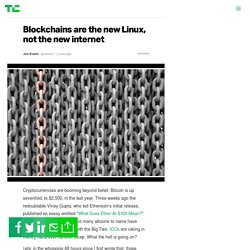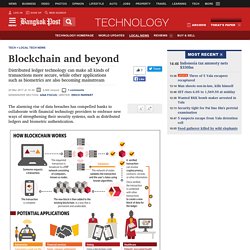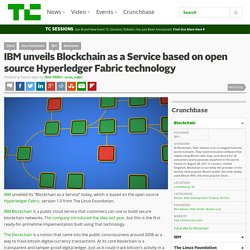

BLOCKCHAIN : How Blockchain Can Improve The Health Information Exchange. BLOCKCHAIN : Estonian eHealth and the blockchain. In less than a year after the Estonian eHealth Foundation announced that it planned to use blockchain technology to secure the public health records of Estonia's 1.3 million citizens, a ground-breaking system was up and running.

The system facilitates improved access to vital information for health professionals, while simultaneously guaranteeing patient confidentiality and the integrity of their files. It's a holy grail of healthcare. Some of the brightest and best minds on the globe have been applying themselves to the issue of making blockchain both practically useful and commercially viable. So how did the Estonian state and a local firm partner up to achieve what others are still only aspiring to? What is blockchain? To understand fully the significance of the achievement, it's best to take a step back and look at what blockchain technology is. The most famous blockchain is the one that underpins the online currency Bitcoin. BLOCKCHAIN : The Healthcare Industry Turns to Blockchain Tech for Security. BLOCKCHAIN : How Blockchain Can Prevent Storage Scams That Hit Banks.
Blockchain is a distributed ledger that holds records of digital data or events in a way that makes them tamper-resistant.

While many users may access, inspect or add to the data, they can’t change or delete it. The original information stays put, leaving a permanent and public information trail, or chain of transactions. Blockchain technology enables participants who do not necessarily trust each other to engage in transactions without a trusted intermediary. This powerful disintermediation could find many uses in the supply chain management field, especially in warehouse receipts, which are suffering from massive-scale forgeries. Paper fraud in metals trading When we think about modern financial markets, we naturally imagine cutting-edge gear and high-tech technologies.
Therefore, metal traders must rely on documents known as warehouse receipts to guarantee the existence and ownership of every pound involved in a transaction. Qingdao affair. Blockchains are the new Linux, not the new Internet. Cryptocurrencies are booming beyond belief.

Bitcoin is up sevenfold, to $2,500, in the last year. Three weeks ago the redoubtable Vinay Gupta, who led Ethereum’s initial release, published an essay entitled “What Does Ether At $100 Mean?” Since then it has doubled. Too many altcoins to name have skyrocketed in value along with the Big Two. ICOs are raking in money hand over fist over bicep. (eta: in the whopping 48 hours since I first wrote that, those prices have tumbled considerably, but are still way, way up for the year.) A certain seductive narrative has taken hold, is what is going on. BLOCKCHAIN : Simon Johnson, MIT Sloan School of Management - MIT Technology Review.
BLOCKCHAIN : Le Bitcoin et la Blockchain (avec Heu?Reka) — Science étonnante #31. BLOCKCHAIN - Blockchain Collaborative Consortium Membership Reaches 109 Companies And Organizations - New Financial Services Subcommittee To Be Formed With Aim Of Boosting Awareness Of Blockchain Technology Among Financial Institutions. The Blockchain Collaborative Consortium (BCCC) was inaugurated on April 25, 2016, with 34 founding member companies.

The consortium's Chairman is Yoichiro Hirano, CEO, Infoteria Corporation. Leading companies promoting the use of blockchain technology have also since joined, expanding BCCC membership to the current 109 companies and organizations. A decision was also reached to inaugurate the Financial Services Subcommittee in March 2017. Blockchain and beyond. The alarming rise of data breaches has compelled banks to collaborate with financial technology providers to embrace new ways of strengthening their security systems, such as distributed ledgers and biometric authentication.

Distributed ledger technology such as blockchain allows financial institutions -- and for that matter, any industry where transactions occur -- to identify opportunities, test proof of concept, and understand regulatory concerns better, according to the technology consulting firm Capgemini. It represents the new, trusted way for financial institutions to track the true ownership of assets without having to pass through a central authority.
Think of it as an Excel spreadsheet or a digital ledger full of valuable information that is duplicated thousands of times across a network of computers, and designed to be updated regularly in order to prevent thieves from hacking it in one place. "The good news is you are late. "It is all about availability. IBM unveils Blockchain as a Service based on open source Hyperledger Fabric technology. IBM unveiled its “Blockchain as a Service” today, which is based on the open source Hyperledger Fabric, version 1.0 from The Linux Foundation.

IBM Blockchain is a public cloud service that customers can use to build secure blockchain networks. The company introduced the idea last year, but this is the first ready-for-primetime implementation built using that technology.